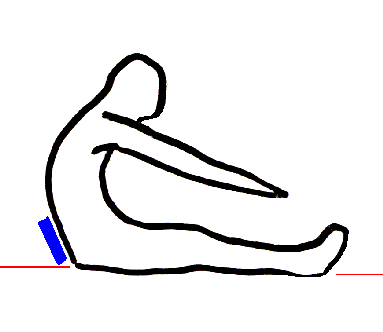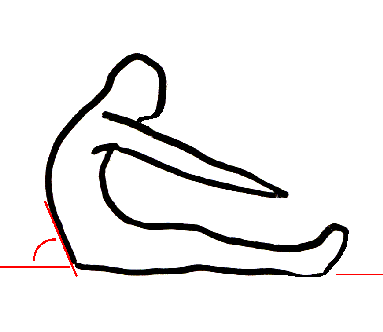Each lab group needs a copy of:
- Hertling, D., & Kessler, R. M. (1996). Management of common musculoskeletal disorders: Physical therapy principles and methods. (3rd ed.). Philadelphia: J.B. Lippincott.
- Kendall, F.P., McCreary, E.K., & Provance, P.G. (1993). Muscles: Testing and Function (4th ed.). Baltimore: Williams & Wilkins.
- On your lab partners, perform the "forward-bending test for hamstring length" (Kendall, McCreary, & Provance, 1993, pp.45-46).

Sit on a flat surface and, with the ankle muscles relaxed but the knees fully extended, reach for the feet. Place a flat, firm, planar object (like a book) on the sacrum, and observe its plane as the person reaches and the pelvis tilts anteriorly.

In the person with normal hamstring length, "the angle between the sacrum and the table is approximately 80 degrees" (p.45). Decide whether this angle will be greater or lesser than 80 degrees in someone whose hamstrings are relatively short.
Next, choose only those lab partners whose hamstring length is normal or relatively short. Passively extend your partner's knee as he or she sits in a "slumped" posture with the pelvis tilted posteriorly. Note the knee joint's "end feel," that is, "the quality of the resistance" that you feel as you approach the endpoint of a passive movement (Kessler & Hertling, 1996, p. 79). You would expect a normal endfeel that is either "capsular or ligamentous."
Repeat the maneuver as your partner sits with the pelvis tilted anteriorly. This posture elongates the hamstrings, producing a passive tension that resists knee extension. You may detect a different, "muscular" end feel (Kessler & Hertling, p.79).
- Devise tests to evaluate the length of each of the following muscles. Therapists perform a muscle length tests by moving each joint that the muscle crosses in a direction that elongates the target muscle.
- extensor carpi radialis longus
- pronator teres
- extensor pollicis brevis
Therapists can use these tests to decide whether a specific muscle is limiting range of motion at one of the joints that it crosses, or whether a muscle is itself injured or contributing to dysfunction in another structure. Length tests can also serve as the basis for exercises that can elongate muscles, decrease their stiffness, and increase their pliability.
Read about, then perform the tests that Kendall et al. (1993, pp.61-65) propose for testing the length of glenohumeral and scapular muscles. Check your understanding by answering these questions.
- Kendall et al. (p.64) show a non-specific test of the length of the lateral (external) rotators. Name three external rotators.
- Why must the glenohumeral joint be externally rotated when the therapist performs the tests for length of the pectoralis major (Kendall, et al., p.62)?
- Why must the person's back rest flat on the table when he or she performs the test for length of the teres major, latissimus dorsi, and rhomboids (Kendall, et al., p.63)?
- If the previous test indicates limited muscle length, but the non-specific test for length of medial (internal) rotators (p. 64) does not, the therapist should suspect shortness of what muscle?
- Stretching is not always advantageous. A person whose spinal cord injury has disrupted the innervation of hand muscles, including the long flexors (FDP and FDS) and the intrinsics (lumbricales and interossei), may rely on relatively short and stiff FDP and FDS to produce a grasp that employs "tenodesis" (Smith, Weiss, & Lehmkuhl, 1996, p. 136).
An example of such a spinal cord injury is one that interrupts innervation that orginates below the level of the sixth spinal segment (refer to the spinal nerve chart in Kendall, McCreary, & Provance, 1993, p. 389). A person with this injury loses all innervation of the FDS and FDP. However,they retain some innervation to the wrist extensors. They can use the wrist extensors to elongate and develop passive force in the long flexors.
However, the person cannot develop functionally useful levels of passive force in the muscles if they become elongated. Therapists must teach the person to use the extremity without stretching the FDP and FDS. Decide how to instruct someone to bear weight on the upper extremities without elongating the finger flexors.
Last updated 3-15-01 Dave Thompson PT
return to PHTH 7243/ OCTH 7242 lab schedule

| Sit on a flat surface and, with the ankle muscles relaxed but the knees fully extended, reach for the feet. Place a flat, firm, planar object (like a book) on the sacrum, and observe its plane as the person reaches and the pelvis tilts anteriorly.

In the person with normal hamstring length, "the angle between the sacrum and the table is approximately 80 degrees" (p.45). Decide whether this angle will be greater or lesser than 80 degrees in someone whose hamstrings are relatively short.
Next, choose only those lab partners whose hamstring length is normal or relatively short. Passively extend your partner's knee as he or she sits in a "slumped" posture with the pelvis tilted posteriorly. Note the knee joint's "end feel," that is, "the quality of the resistance" that you feel as you approach the endpoint of a passive movement (Kessler & Hertling, 1996, p. 79). You would expect a normal endfeel that is either "capsular or ligamentous."
| Repeat the maneuver as your partner sits with the pelvis tilted anteriorly. This posture elongates the hamstrings, producing a passive tension that resists knee extension. You may detect a different, "muscular" end feel (Kessler & Hertling, p.79). | |||
|---|---|---|---|---|---|
- extensor carpi radialis longus
- pronator teres
- extensor pollicis brevis
Therapists can use these tests to decide whether a specific muscle is limiting range of motion at one of the joints that it crosses, or whether a muscle is itself injured or contributing to dysfunction in another structure. Length tests can also serve as the basis for exercises that can elongate muscles, decrease their stiffness, and increase their pliability.
Read about, then perform the tests that Kendall et al. (1993, pp.61-65) propose for testing the length of glenohumeral and scapular muscles. Check your understanding by answering these questions.
- Kendall et al. (p.64) show a non-specific test of the length of the lateral (external) rotators. Name three external rotators.
- Why must the glenohumeral joint be externally rotated when the therapist performs the tests for length of the pectoralis major (Kendall, et al., p.62)?
- Why must the person's back rest flat on the table when he or she performs the test for length of the teres major, latissimus dorsi, and rhomboids (Kendall, et al., p.63)?
- If the previous test indicates limited muscle length, but the non-specific test for length of medial (internal) rotators (p. 64) does not, the therapist should suspect shortness of what muscle?
An example of such a spinal cord injury is one that interrupts innervation that orginates below the level of the sixth spinal segment (refer to the spinal nerve chart in Kendall, McCreary, & Provance, 1993, p. 389). A person with this injury loses all innervation of the FDS and FDP. However,they retain some innervation to the wrist extensors. They can use the wrist extensors to elongate and develop passive force in the long flexors.
However, the person cannot develop functionally useful levels of passive force in the muscles if they become elongated. Therapists must teach the person to use the extremity without stretching the FDP and FDS. Decide how to instruct someone to bear weight on the upper extremities without elongating the finger flexors.